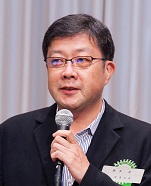Revitalizing Local Communities through Fostering Young Creators
May 10, 2017
Mr. Jun Suzuki
Incubation Manager, Taito Designers-Village
�� Taito Ward of Tokyo has long housed a large number of handicraft artisans who created products to be distributed to retailers based around Sensouji Temple, Kan��eiji Temple and Nihonbashi. Taito Ward is the smallest among 23 special wards in terms of size, yet its population of 464,000 had been the largest before the War. By 1960, its population declined to 320,000 and further halved to 150,000 by 2000. As many as 14 schools closed down since 1990 and the municipal office had to identify ways to make use of these facilities.
Taito Ward of Tokyo has long housed a large number of handicraft artisans who created products to be distributed to retailers based around Sensouji Temple, Kan��eiji Temple and Nihonbashi. Taito Ward is the smallest among 23 special wards in terms of size, yet its population of 464,000 had been the largest before the War. By 1960, its population declined to 320,000 and further halved to 150,000 by 2000. As many as 14 schools closed down since 1990 and the municipal office had to identify ways to make use of these facilities.
��The southern half of Taito Ward, extending from Okachimachi to Kuramae, is known as ��Kachikura�� and has attracted craftspeople and wholesalers specialized in fashion items, such as hats, jewelry, accessories and belts. As high brands started to expand their production bases overseas, they were urged to create high value-added designs. However, the talent pool was limited within the Ward and the municipal office tried to tap into competent designers externally.
��Taito Designers Village was established in 2004. It is a former elementary school transformed into studios and ateliers, serving as an incubation center for young creators. Tenants pay very low rent but they have to get established as an artist during the three-year tenancy. I was appointed Incubation Manager responsible for fostering talented new creators. I was determined to attract highly-motivated designers and to make the Village the gateway to success in the fashion business. I also strove to revitalize the area through manufacturing, just like Paris or Milan, and to assist young designers in launching their businesses to eventually make their products distributed throughout the world. I admit I had to overcome different obstacles, like getting support and understanding from the municipal office and the general public on what the Designers Village aimed to achieve. After four years, things started to get on the right track.
��To date, we have 77 graduates who have started their own brands, shops and galleries. While less than 20% of them are originally from Taito Ward, half of the graduates have chosen to stay in the neighborhood to which they had become attached. We have been providing business advice to resident designers as well as facilitated networking among designers in different trades and local manufacturers. Young creators with innovative ideas visited workshops and ateliers to learn how skilled craftsmen worked meticulously and tirelessly. By developing ties with local manufacturers, they could make good use of their knowhow, knowledge and experience to start a successful business. I witnessed not a few craftsmen became encouraged and motivated as young creators praised their commitment and skills.
��We also started an Open Village, which grew into an annual event, where anyone can walk in; purchase some of the works directly from the creators and exchange with artisans and young designers. By 2010, we aimed to expand this event to the whole neighborhood and called upon local businesses, entrepreneurs and graduates of the Village to organize a festival ��Monomachi (meaning community development through craftsmanship)��. Our goal was to attract more visitors and help them experience Taito Ward as a community of professional craftsmanship. The first two-day Festival was held in May 2011 where 16 local businesses and Village graduates opened their factories and ateliers to the public while 50 creators participated in the hand-made marché. We were delighted to welcome a large number of visitors who filled the Satake Shopping Arcade with excitement. Each time, the Festival has been expanding in its scale and the number of visitors keeps rising. The second Festival held 6 months later had 62 local businesses and shops as well as 114 creators participate and the Shopping Arcade was literally packed with visitors despite the rough weather. The third Festival had 120 participating businesses, followed by the forth Festival where 257 businesses and 400 creators united to demonstrate their craftsmanship in the area extending over 2 square kilometers and recorded a total number of 100,000 visitors.
��The Festival succeeded in facilitating communication and networking among artisans, creators, entrepreneurs, shop owners, local residents and volunteers of different backgrounds and generations. They have worked together to revitalize the neighborhood, deepened friendships and developed a new community. The area has increasingly gathered attention, getting more media coverage, and is attracting an increasing number of visitors. New shops and apartment buildings are also being constructed.
����Monomachi�� Festival has become a year-round activity to boost the local community and is run by the younger generation. We hope that when Tokyo hosts the Olympic and Paralympic Games in 2020, visitors from around the world can purchase goods and products directly from the creators having business in the locality. We hope to see many of you at the upcoming ��Moonachie�� Festival to be held from 26 to 28 May. Thank you.